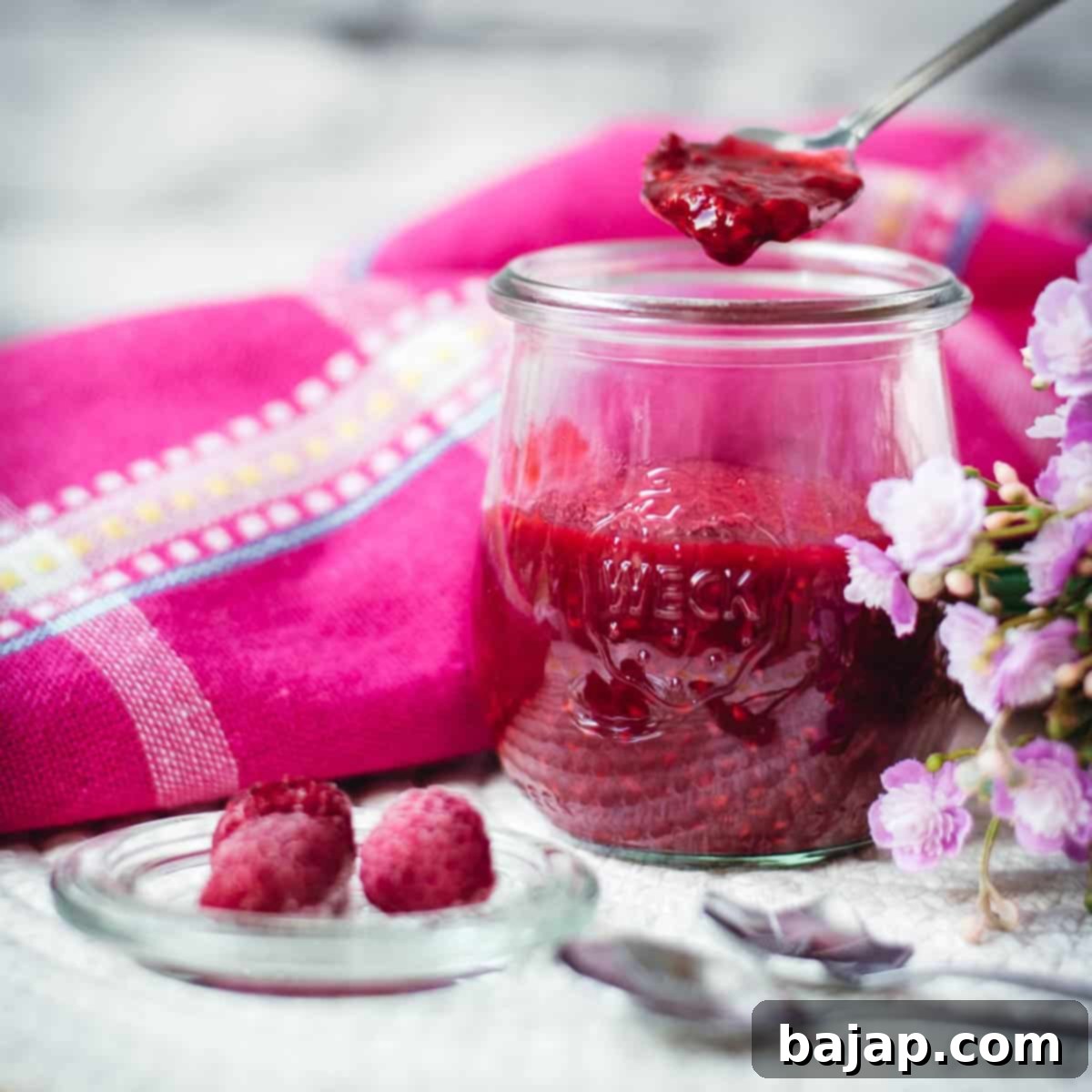Easy Homemade Raspberry Sauce: The Perfect Topping for Cheesecakes, Ice Cream & More
Get ready to transform your desserts with this incredibly simple yet utterly delicious raspberry sauce! Whether you’re topping a classic cheesecake, drizzling over creamy vanilla ice cream, or enhancing your favorite baked goods, this homemade raspberry sauce is an absolute game-changer. It’s surprisingly quick to prepare, requires minimal kitchen tools, and offers a delightfully refreshing, sweet-tart flavor that’s never overpoweringly sugary.
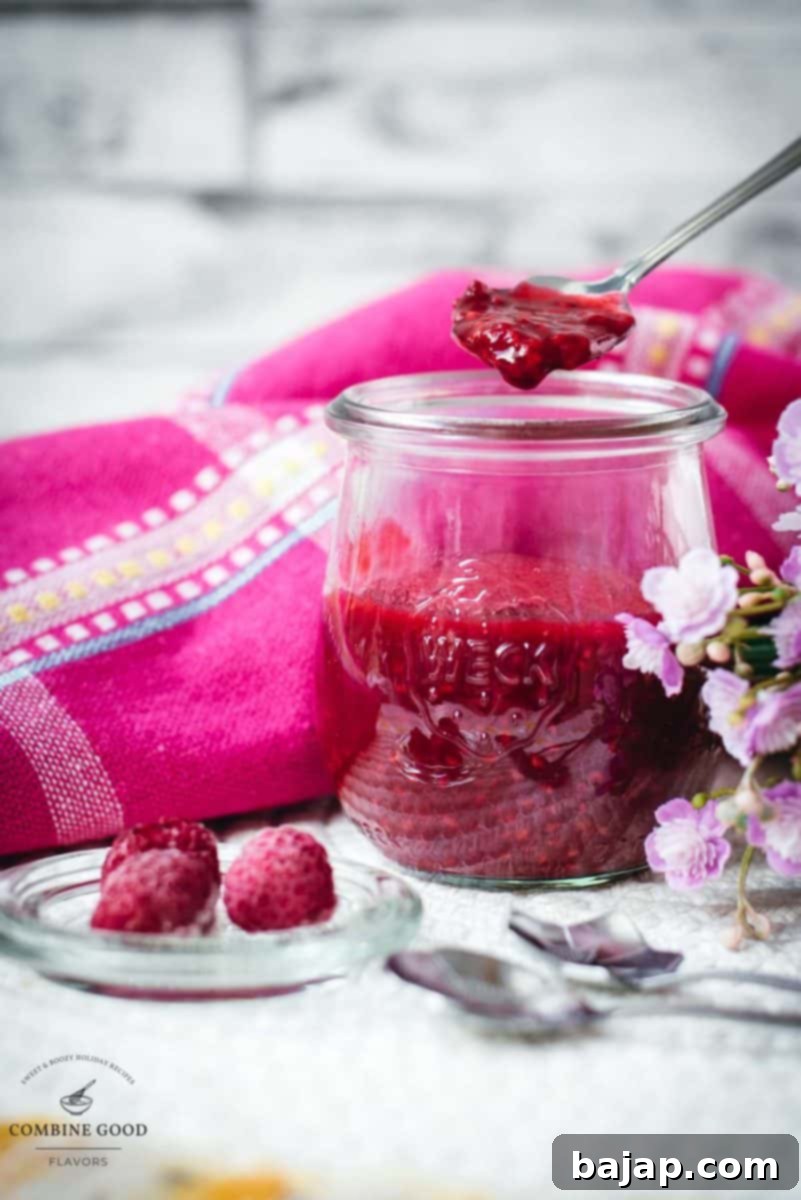
We’ve thoroughly tested this versatile raspberry topping on a variety of treats, from rich baked cheesecakes to light and tangy no-bake lemon cheesecakes, the delightful Austrian Kaiserschmarren, and even as a vibrant addition to sour cream and our classic homemade vanilla ice cream. The verdict? It’s been an absolute sensation every single time, earning rave reviews for its fresh taste and effortless preparation.
So, why wait? Gather your fresh raspberries, a trusty saucepan, and a wooden spoon, and let’s dive into creating this indispensable dessert sauce!
Why Make Your Own Raspberry Sauce?
While store-bought options exist, crafting your own raspberry sauce at home offers numerous advantages. You get complete control over the sweetness, allowing you to tailor it perfectly to your preference or dietary needs. There are no artificial colors, flavors, or preservatives – just the pure, vibrant taste of fresh fruit. Plus, it’s often more cost-effective and the process itself is wonderfully satisfying. The aroma of simmering raspberries filling your kitchen is an added bonus! This easy recipe ensures a smooth, luscious texture that rivals any gourmet sauce, making it a staple in your dessert repertoire.
🥘 Essential Ingredients
Making this delightful raspberry sauce requires just a few basic ingredients, most of which you likely already have on hand. Each plays a crucial role in achieving that perfect balance of flavor and texture:
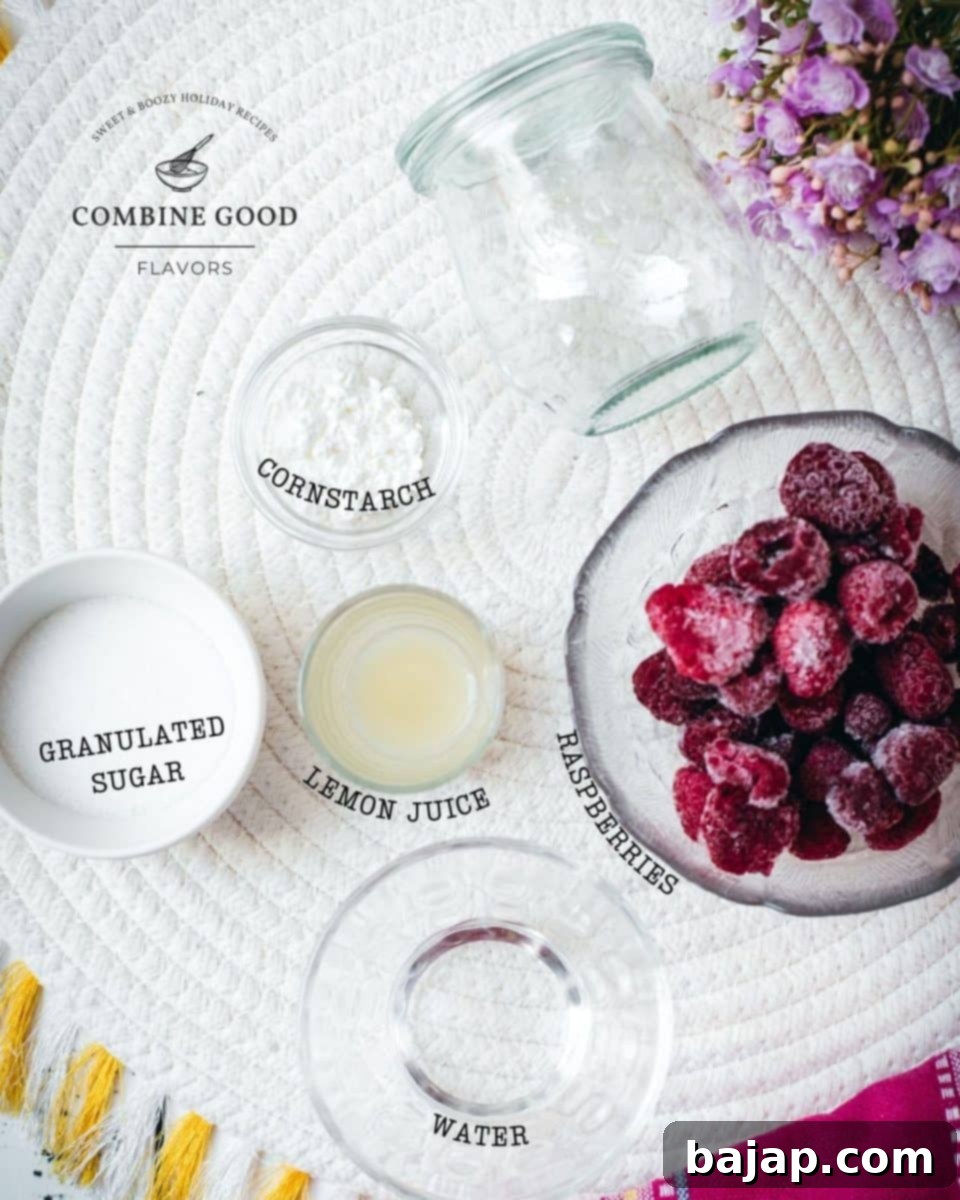
- Raspberries – Fresh or Frozen: The star of our show! Fresh raspberries offer the brightest, most intense flavor, especially when in season. However, frozen raspberries work beautifully and are a fantastic option year-round. There’s no need to thaw them beforehand; they’ll cook down perfectly in the saucepan, releasing their juices to create a rich base for the sauce. Look for plump, vibrantly colored berries.
- Granulated Sugar: This provides the necessary sweetness to balance the natural tartness of the raspberries. The beauty of homemade sauce is that you can truly adjust the amount to your personal taste. If your raspberries are exceptionally sweet, you might need less sugar. For a lower-sugar option, consider alternatives like a touch of maple syrup or a sugar substitute, adjusting to achieve your desired sweetness level.
- Water: Primarily used to create a “slurry” with the cornstarch. Using cold water for the slurry is key to prevent lumps and ensure your sauce thickens smoothly and evenly, resulting in a perfectly viscous consistency.
- Cornstarch: Our thickening agent! Cornstarch is essential for giving the sauce its ideal consistency, allowing it to coat your spoon (and your cheesecake) beautifully. Dissolving it thoroughly in cold water to form a slurry before adding it to the warm raspberry mixture is crucial. This technique prevents the cornstarch from clumping and ensures a silky-smooth finish.
- Lemon Juice: A splash of freshly squeezed lemon juice is a secret weapon in this recipe. It’s not just for tartness; it brightens the overall flavor of the raspberries, enhances their natural fruitiness, and provides a lovely counterpoint to the sweetness. For the best flavor, always opt for freshly squeezed lemon juice. For more insights into using lemons, check out our helpful blog posts “How Much Lemon Juice is in One Lemon” and “The Complete Guide to Freshly Squeezed Lemon Juice.”
For exact measurements, please refer to the comprehensive recipe card located further down.
🔪 Step-by-Step Instructions
Crafting this luscious raspberry sauce is surprisingly straightforward. Follow these simple steps for a perfect result every time:
Step 1: Combine Raspberries and Sugar. If using fresh raspberries, gently wash them and place them directly into a medium saucepan. Add the granulated sugar. Place the saucepan over medium heat. This initial gentle heat will help the raspberries start to break down and release their beautiful, vibrant juices.
Step 2: Simmer and Mash. Continue to warm the raspberries and sugar. As the mixture heats, the raspberries will soften and begin to release a fragrant, ruby-red juice. Use a fork or a potato masher to gently break apart some of the raspberries. You can choose your desired texture here: mash more for a smoother sauce, or mash less for a chunkier, more rustic topping with discernible fruit pieces.
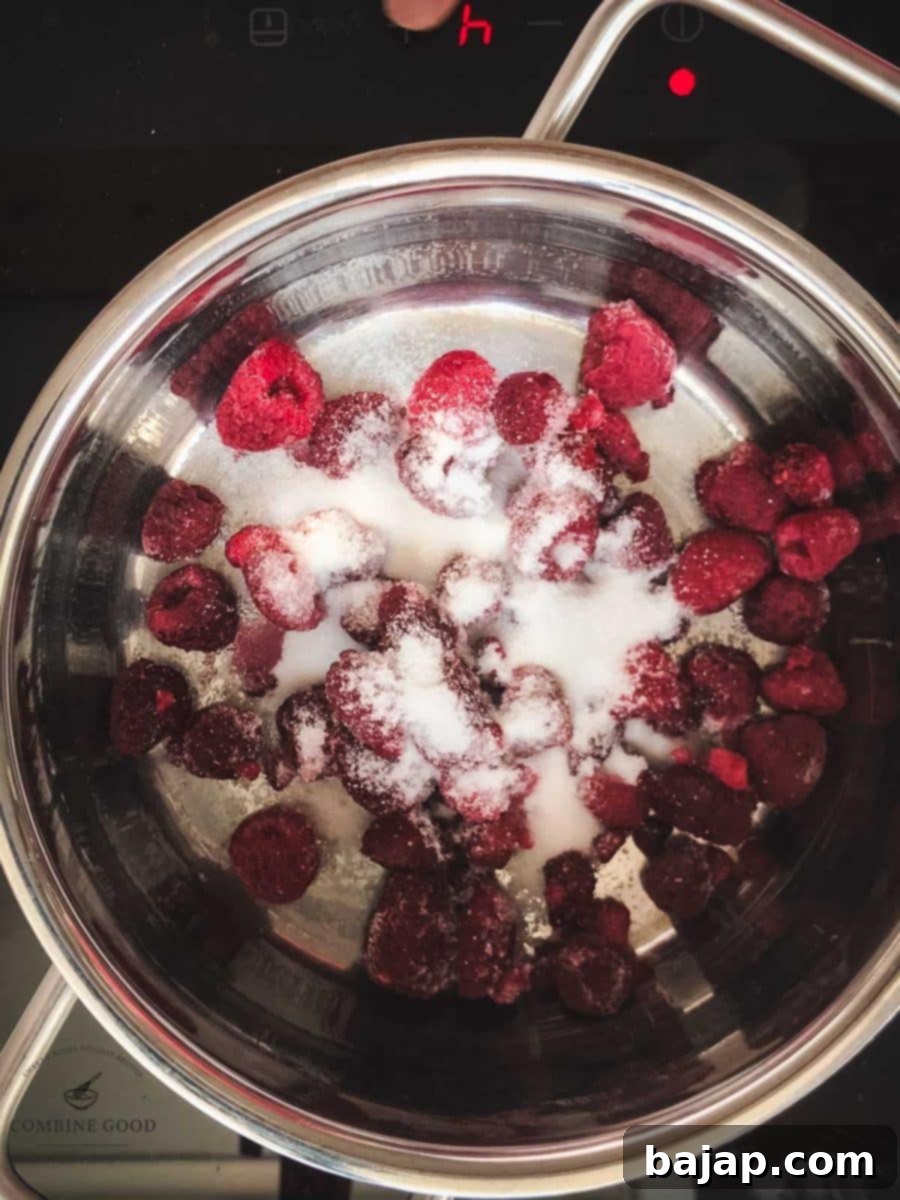
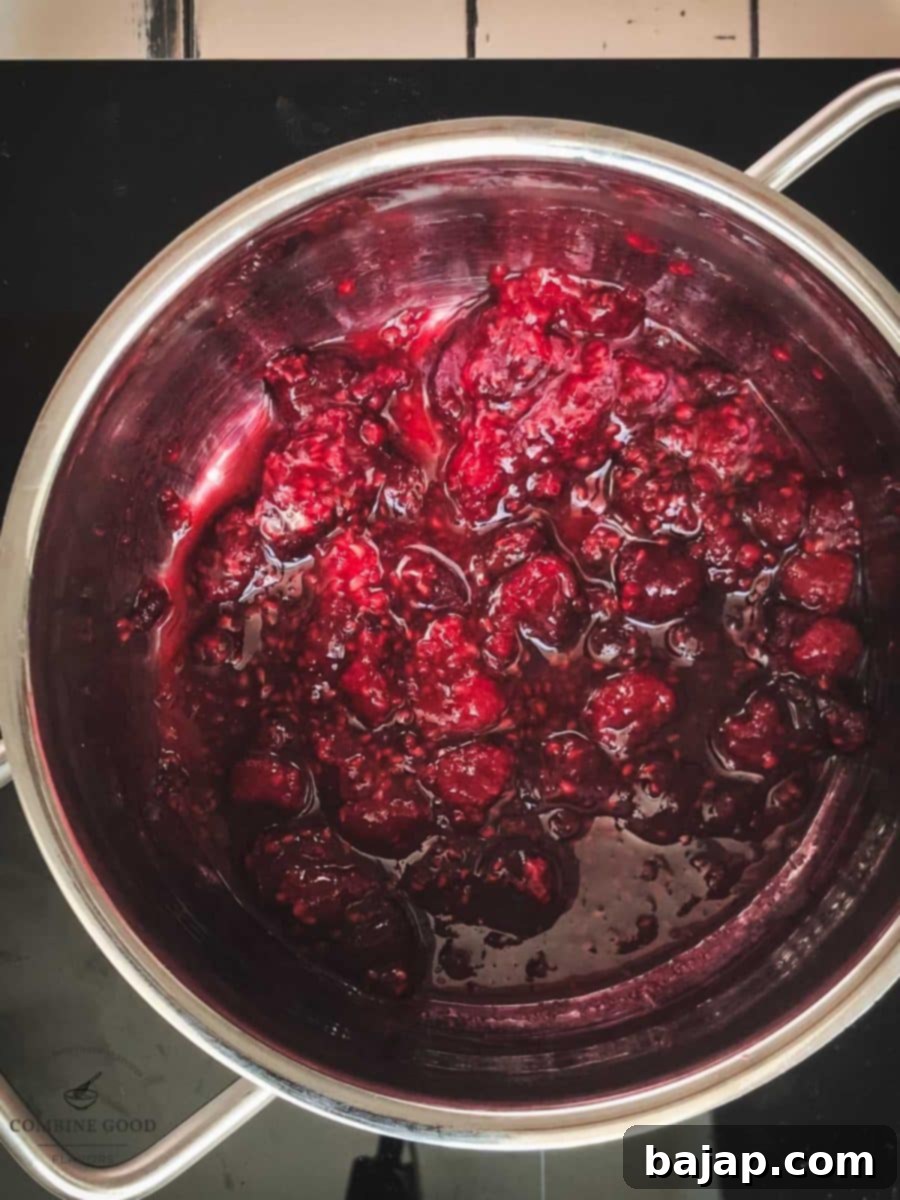
Step 3: Prepare the Cornstarch Slurry. In a small, separate bowl, combine the cold water and cornstarch. Whisk vigorously until the cornstarch is completely dissolved and no lumps remain. This step is critical; adding dry cornstarch directly to a hot liquid will result in clumps and an unevenly thickened sauce. The slurry ensures a smooth, consistent thickening process.
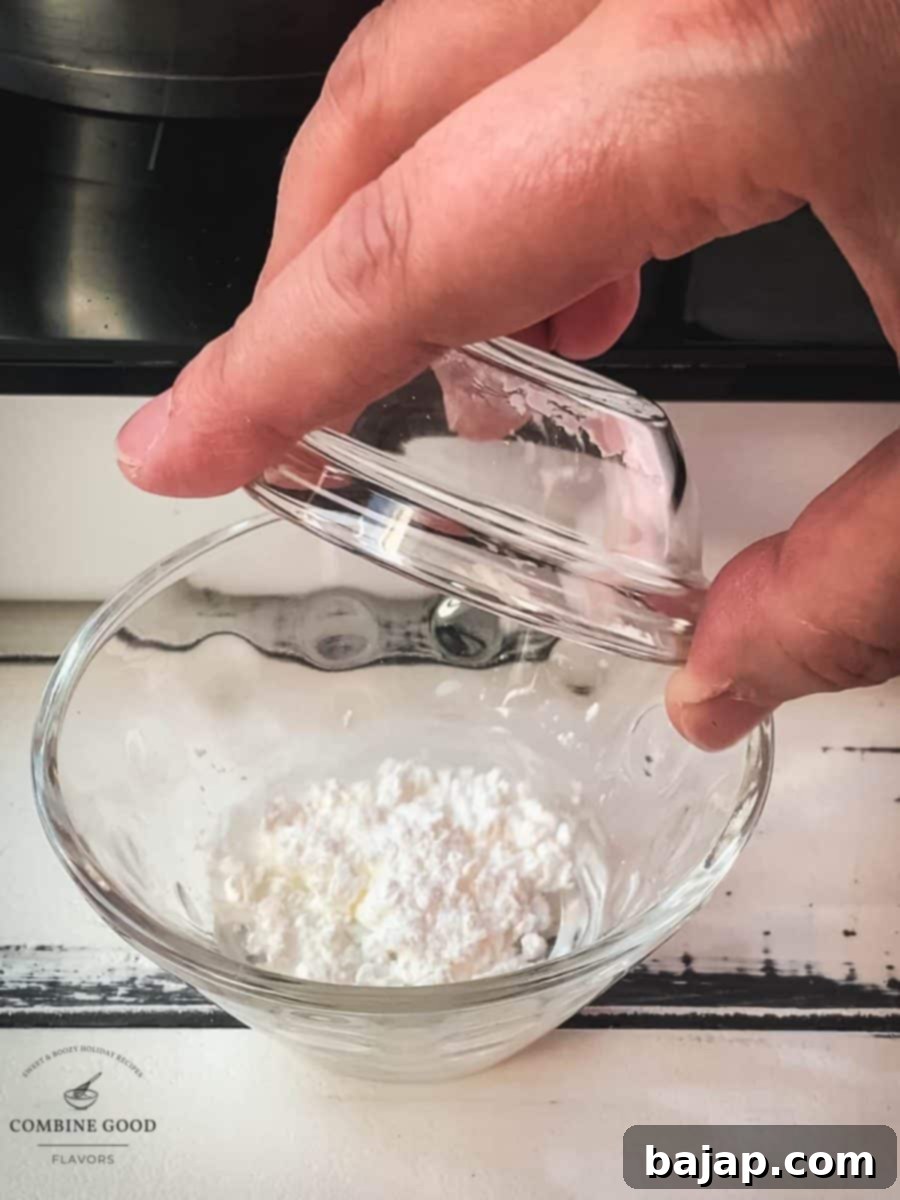
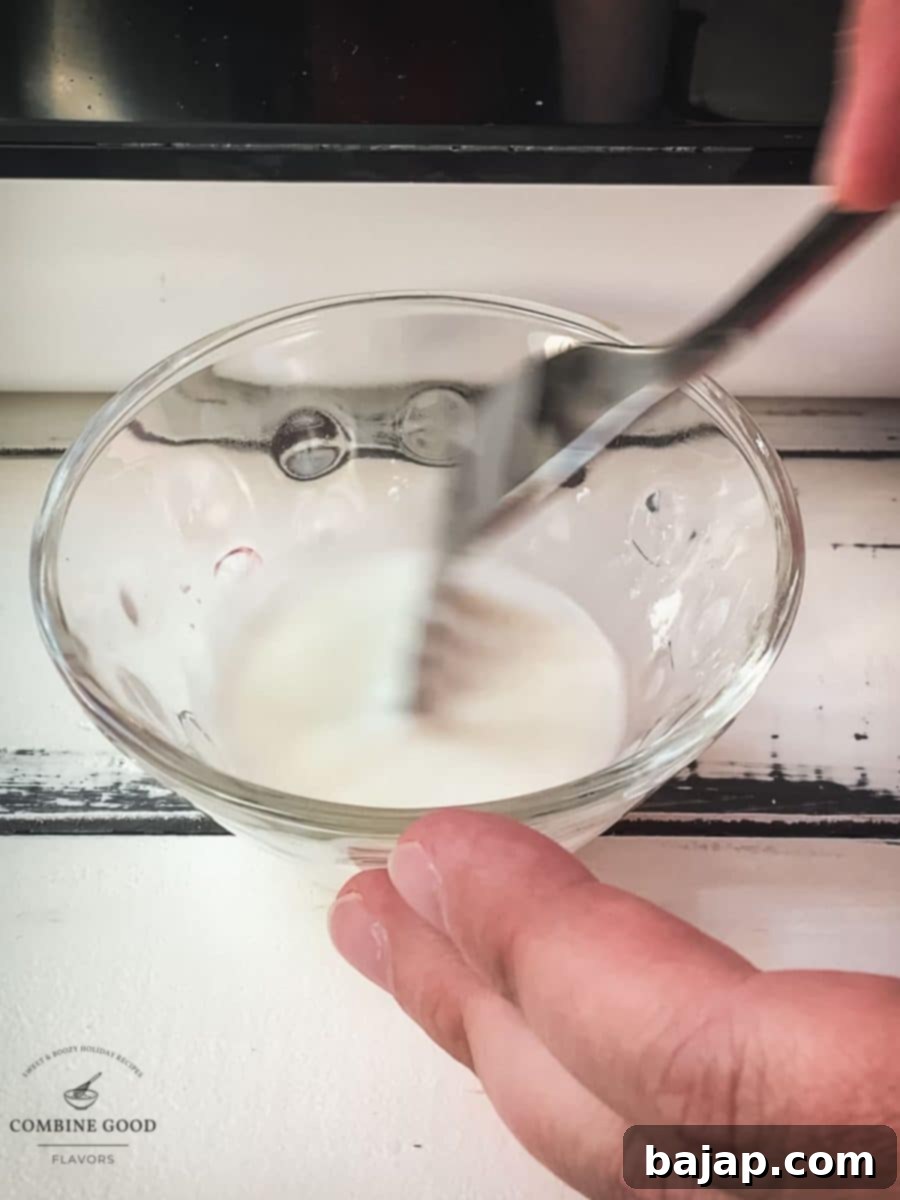
Step 4: Thicken the Sauce. Gradually pour the cornstarch slurry into the simmering raspberry mixture in the saucepan. Stir continuously with a whisk or wooden spoon. You’ll notice the sauce begin to thicken almost immediately. Keep stirring gently to ensure even distribution of the thickener and to prevent sticking.
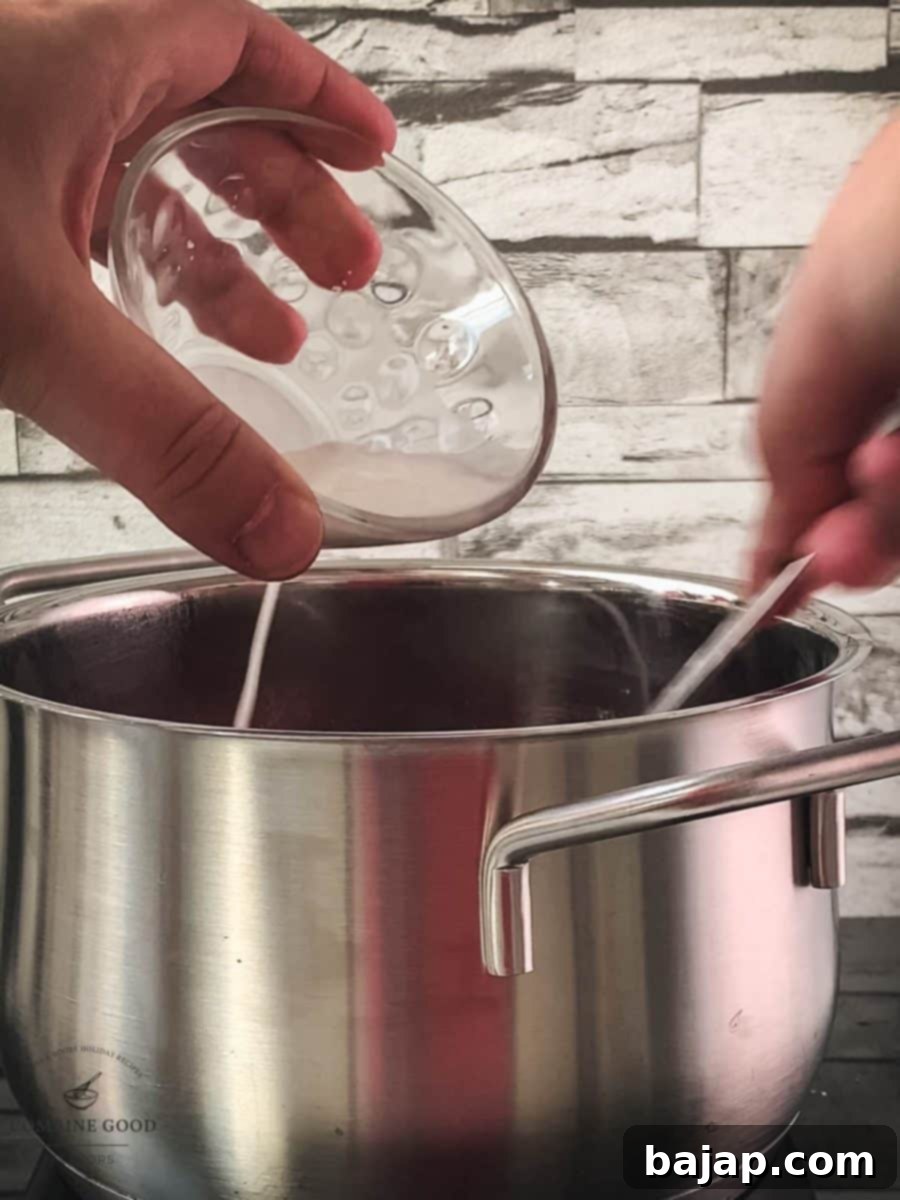
Step 5: Add Lemon Juice for Brightness. Once the sauce has thickened to your desired consistency, stir in the fresh lemon juice. This is best added towards the end of cooking to preserve its bright, fresh flavor, which can be diminished by prolonged heat.
Step 6: Final Thicken and Serve. Allow the sauce to simmer and thicken for an additional 2-3 minutes after adding the lemon juice, stirring occasionally. This ensures the cornstarch is fully cooked and the sauce reaches its optimal texture. Remove the saucepan from the heat. You can serve this delightful raspberry sauce immediately, warm over your favorite desserts, or let it cool completely before storing it in a clean preserving jar or airtight container in the refrigerator.
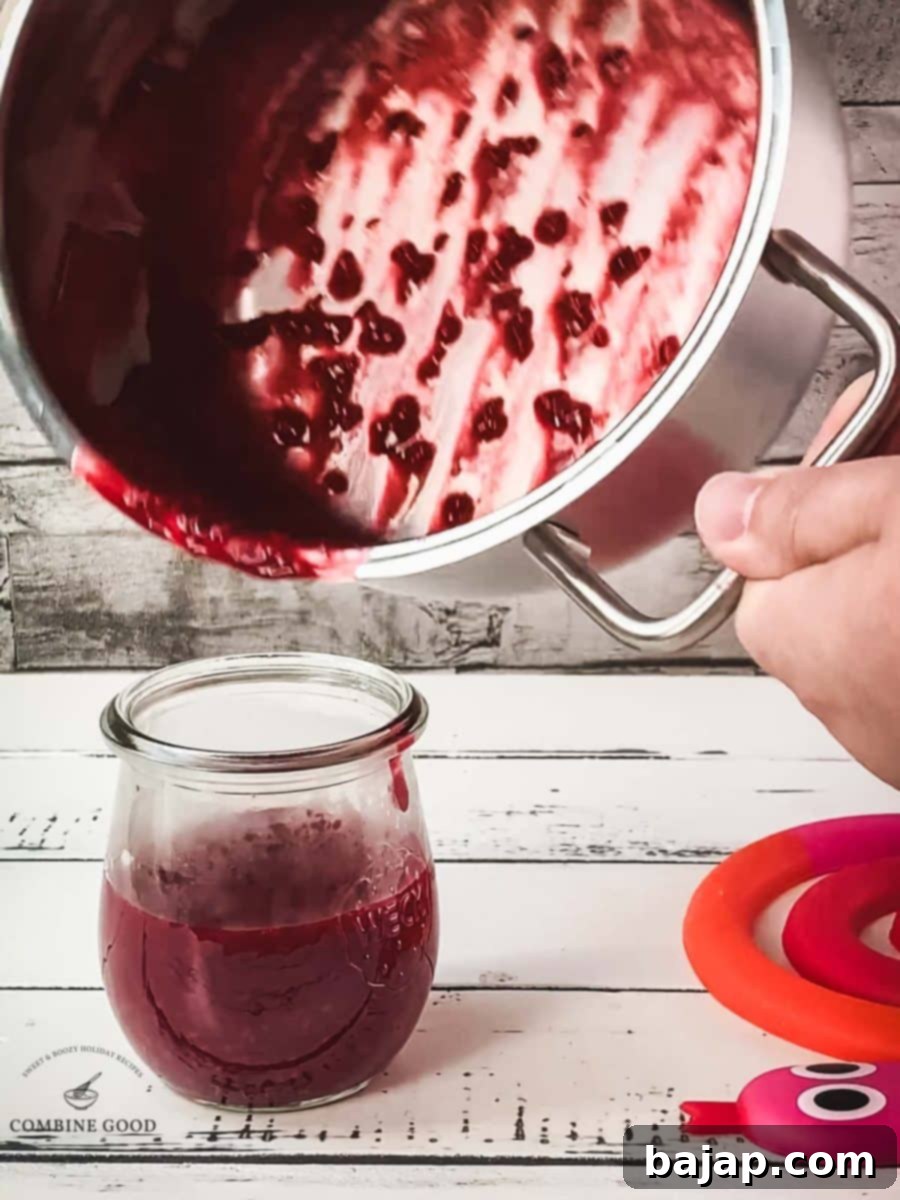
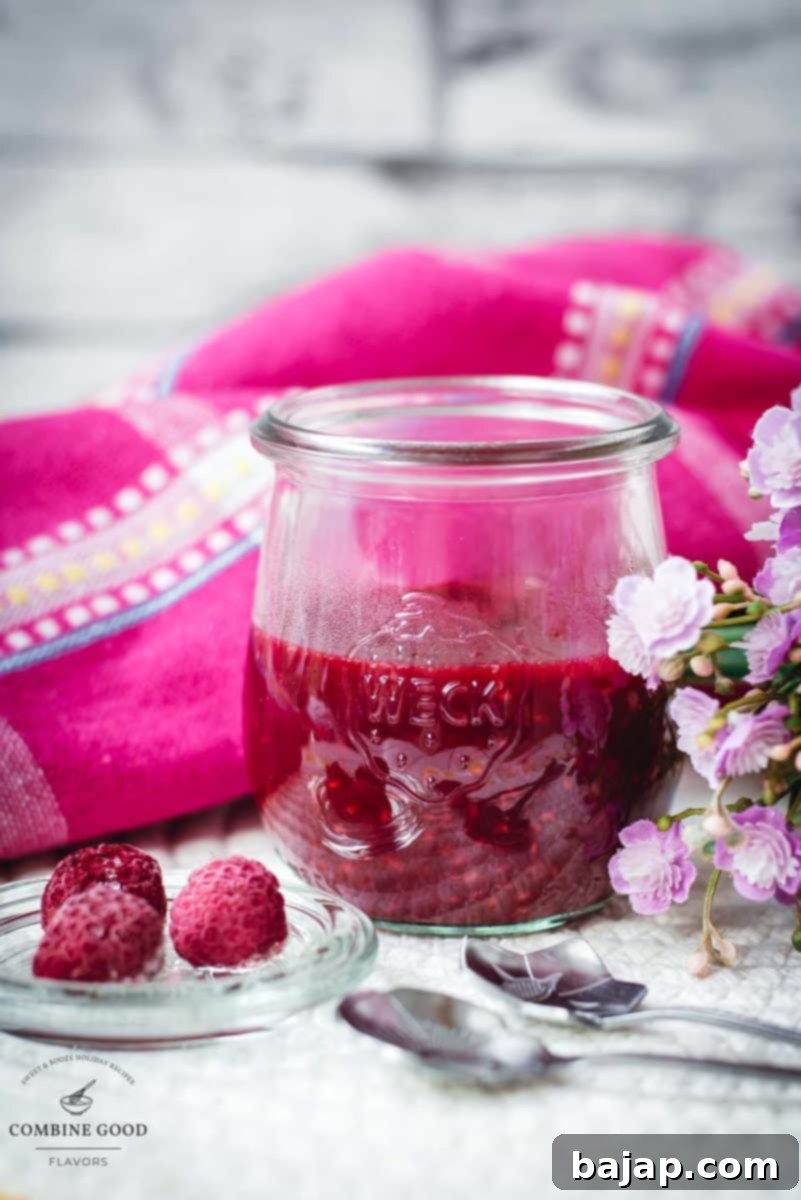
🍓 Substitutions & Customization
One of the best things about this raspberry sauce recipe is its flexibility! You can easily adapt it to suit your preferences or what you have on hand.
- Other Berries: If raspberries aren’t your top choice or aren’t in season, feel free to substitute them with other fresh or frozen berries. Juicy strawberries, sweet blueberries, tangy blackberries, or even a mix of berries will create equally delicious sauces. Remember, the natural sweetness and tartness of other fruits might require a slight adjustment to the sugar and lemon juice.
- Sweetness Level: As mentioned, adjust the granulated sugar to your taste. For a richer, more complex sweetness, you could try a touch of brown sugar, honey, or maple syrup. Just be mindful that liquid sweeteners might slightly alter the consistency.
- Smooth or Chunky: If you prefer a completely smooth sauce, simply pass the cooked raspberry mixture through a fine-mesh sieve before adding the cornstarch slurry. This will remove all seeds and fruit pulp, yielding a velvety-smooth coulis. For a chunkier sauce, mash fewer raspberries in Step 2.
- Flavor Boosters: Elevate your sauce with a hint of vanilla extract, almond extract, or a tiny pinch of cinnamon for added warmth. A very small amount of orange zest can also add a beautiful citrus aroma that complements the raspberries.
- Thickening Agents: While cornstarch is our go-to for its clear finish and neutral taste, you could also use arrowroot powder as an alternative. Use the same quantity and method for creating a slurry.
💕 Perfect Pairings for Your Raspberry Sauce
This vibrant raspberry sauce is incredibly versatile and pairs wonderfully with a wide array of desserts and breakfast dishes. Here are some of our favorite ways to enjoy it:
- No-Bake Lemon Cheesecake: The bright, tangy notes of this raspberry sauce provide a sublime contrast to the creamy, citrusy flavors of a no-bake lemon cheesecake. It’s a match made in dessert heaven!
- Kaiserschmarrn: This traditional Austrian shredded pancake benefits immensely from a generous drizzle of raspberry sauce. The fruity tartness perfectly cuts through the richness of the pancake, creating a delightful blend of sweet and tangy in every bite.
- Vanilla Ice Cream: A classic pairing! The refreshing raspberry sauce enhances the rich, smooth taste of homemade vanilla ice cream, creating a simple yet elegant dessert that’s perfect on a warm day.
- 3-Ingredient Yogurt Cake: Elevate a simple, moist yogurt cake with a burst of fruity flavor from this luscious raspberry sauce. It adds moisture and a vibrant taste that makes the cake feel much more indulgent.
- Chocolate Chip Vanilla Ice Cream: The bright, tangy raspberry sauce creates an exciting flavor profile when paired with the creamy sweetness and chocolate chips in vanilla ice cream. The tart raspberries beautifully complement the rich chocolate.
- Pancakes & Waffles: Ditch the maple syrup occasionally and top your breakfast pancakes or waffles with this fresh raspberry sauce for a fruity start to your day.
- Yogurt Parfaits & Oatmeal: Stir a spoonful of this sauce into your morning yogurt or oatmeal for a natural sweetener and a boost of berry flavor.
- Panna Cotta: The smooth, silky texture of panna cotta is beautifully complemented by the vibrant and slightly tart raspberry sauce.
- Crepes: Whether for breakfast or dessert, warm crepes filled with a spoonful of this raspberry sauce are simply irresistible.
- Pound Cake or Angel Food Cake: A slice of plain pound cake or angel food cake transforms into an elegant dessert with a generous dollop of homemade raspberry sauce and a bit of whipped cream.
🌡 Storage & Top Tips for Success
To ensure your raspberry sauce is perfect every time and stays fresh for as long as possible, keep these tips in mind:
- Storage: Once your raspberry sauce has fully cooled to room temperature, transfer it to a clean, airtight container or a preserving jar. Stored properly in the refrigerator, this sauce will remain fresh and delicious for up to two weeks. If you want to keep it longer, you can freeze it in freezer-safe containers for up to 3 months. Thaw in the refrigerator overnight before use.
- Fresh vs. Frozen Raspberries – A Deeper Dive: While fresh raspberries are fantastic, frozen ones are a convenient and equally delicious alternative. If you’re using frozen raspberries, there’s no need to thaw them; simply add them to the saucepan as directed. They will release more liquid than fresh raspberries, which means the cooking time might be slightly longer, or you might need a tiny bit more cornstarch slurry to achieve your desired thickness. Don’t worry, the flavor will still be outstanding!
- The Lemon Juice Difference: Always use freshly squeezed or high-quality bottled lemon juice. Avoid lemon extract, as it can impart an artificial, almost candy-like flavor that detracts from the natural freshness of the raspberries. The acid in fresh lemon juice is crucial for balancing sweetness and enhancing the fruit’s natural notes.
- Adjusting Consistency: If your sauce turns out too thin, you can create a small additional cornstarch slurry (1 teaspoon cornstarch mixed with 1 tablespoon cold water) and whisk it into the simmering sauce. Cook for another minute or two until thickened. If it’s too thick, simply stir in a tablespoon or two of water until it reaches your desired consistency.
- Preventing Skin Formation: As the sauce cools, a skin might form on the surface. To prevent this, gently press a piece of plastic wrap directly onto the surface of the warm sauce before refrigerating. This creates a barrier and keeps it smooth.
🍽 Recommended Equipment
Making this raspberry sauce requires only a few standard kitchen items:
- Saucepan: A medium-sized saucepan is perfect for simmering the raspberries.
- Fork: Useful for gently mashing some of the raspberries to release their juices and achieve your desired texture.
- Whisk: Essential for smoothly combining the cornstarch and water into a slurry, and for stirring the sauce as it thickens to prevent lumps.
- Mixing Bowl: A small bowl is needed to prepare the cornstarch slurry.
- Lemon Squeezer: To efficiently extract fresh lemon juice, ensuring you get every last drop for optimal flavor.
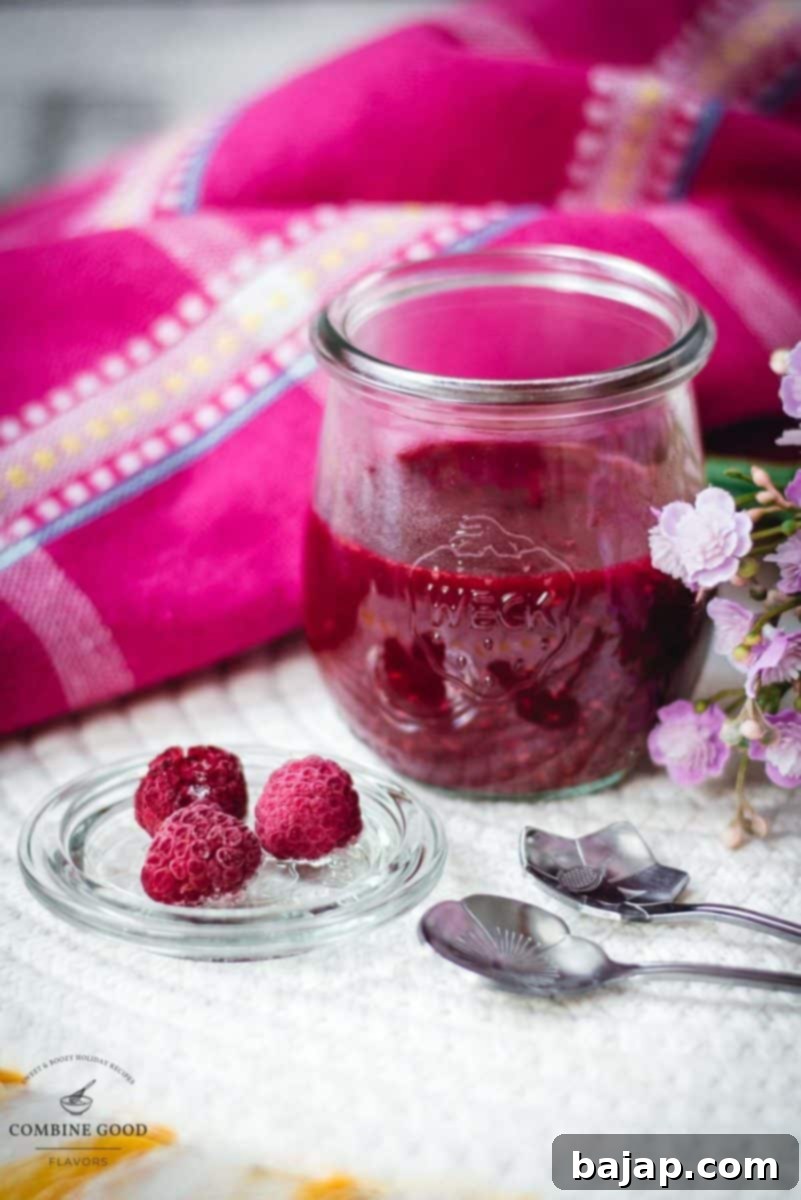
Other Delicious Raspberry Recipes for You to Try
If you love the bright, sweet-tart flavor of raspberries, you’re in luck! We have a whole collection of recipes that celebrate this wonderful berry. Expand your raspberry repertoire with these fantastic creations:
- Raspberry Daiquiri
- Raspberry Margarita Recipe
- Raspberry Gin and Tonic
- Raspberry Almond Thumbprint Cookies
- Valentines Raspberry Cheesecake {no-bake}
- Homemade Raspberry Syrup {no cooking}
- Raspberry Lemon Drop Martini Recipe
- The Joy of Homemade Raspberry Syrup
- 5 Ingredients Raspberry Cheesecake Thumbprint Cookies
- Spooktacular Cheesecake with “Bloody” Raspberry Filling
- Patriotic Fourth of July no-bake Cheesecake
If you try this delightful easy raspberry sauce recipe, we’d love to hear from you! Please let us know how you liked it by giving it a ★★★★★ star rating and leaving a comment below. Your feedback means the world to us! You can also sign up for our Newsletter to receive weekly delicious homemade recipes directly to your inbox. Don’t forget to follow me on Pinterest or Instagram and share your beautiful creations with us. Just tag me @combinegoodflavors and use the hashtag #combinegoodflavors, so I don’t miss seeing your culinary masterpieces!
📖 Recipe Card
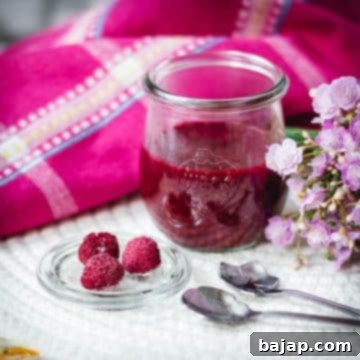
Easy Raspberry Sauce
Nora
Save RecipeSaved!
Pin Recipe
Equipment
-
Saucepan
-
Fork
-
Whisk
-
Mixing bowl
-
Lemon squeezer
Nutrition values are estimates only, using online calculators. Please verify using your own data.

⛑️ Food Safety Guidelines
Ensuring food safety is paramount when preparing any recipe. Please keep these important guidelines in mind:
- Proper Cooking Temperature: Always cook foods, especially those containing fruit, to a minimum internal temperature of 165 °F (74 °C) to eliminate harmful bacteria.
- Prevent Cross-Contamination: Never use the same utensils, cutting boards, or containers for cooked food that previously touched raw ingredients without thoroughly washing them first.
- Hand Hygiene: Wash your hands thoroughly with soap and warm water for at least 20 seconds before, during, and after handling food.
- Avoid Extended Room Temperature Exposure: Do not leave perishable foods, including this sauce, sitting out at room temperature for more than two hours. If the ambient temperature is above 90 °F (32 °C), this time reduces to one hour.
- Never Leave Cooking Unattended: Always monitor food when cooking on the stove or in the oven to prevent burning or other hazards.
- High Smoke Point Oils: When cooking, use oils with a high smoke point to avoid breaking down and forming harmful compounds. (Note: This specific tip is less relevant for a raspberry sauce but is a general food safety principle).
- Ensure Good Ventilation: Always use good ventilation, such as an exhaust fan, when cooking with a gas stove to prevent the buildup of harmful gases.
For further comprehensive information on safe food handling practices, please consult the Safe Food Handling guide from the FDA.
